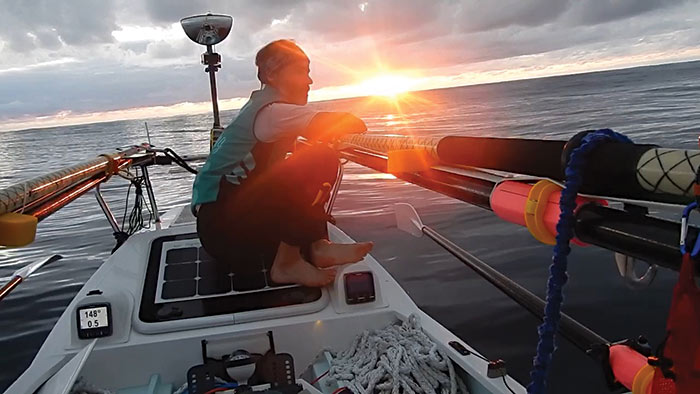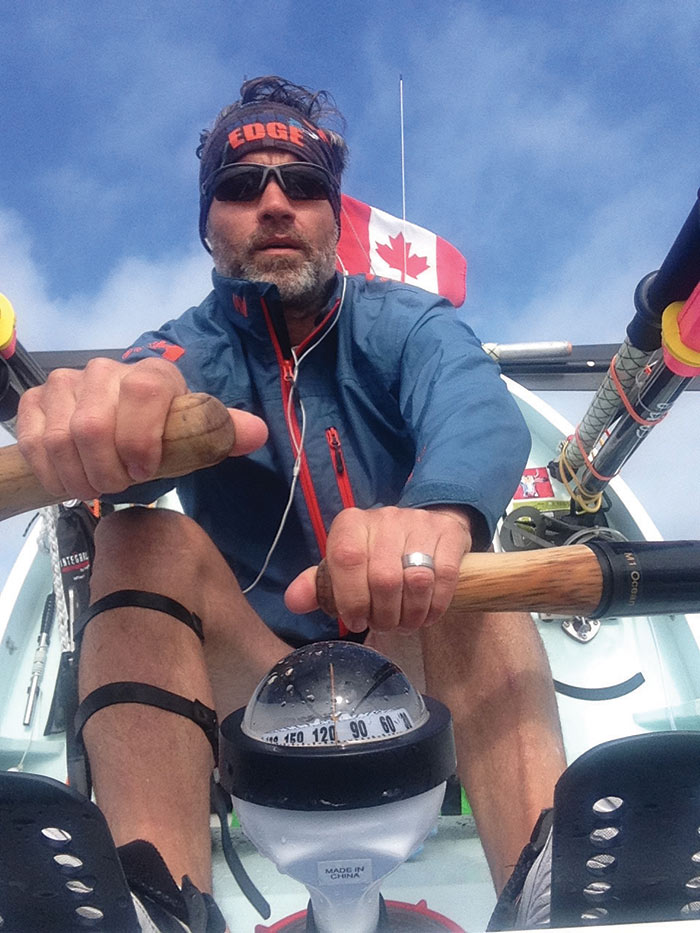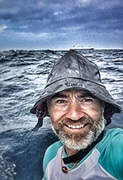Our Stories: Ocean of Memories
Canadian North Pilot Rows the Atlantic for Charity
By John Perkinson, Senior Staff Writer

Capt. Laval St. Germain (Canadian North) rows from Canada to France in his custom-built ocean-rowing vessel TrueBlue to raise money for charity.
International airline pilots often fly “across the pond,” but few can say they’ve rowed it. That’s precisely what Capt. Laval St. Germain (Canadian North) did this past summer. Setting out from Halifax, Nova Scotia, Canada, on June 15 in his custom-built ocean-rowing vessel TrueBlue, he crossed the North Atlantic Ocean by himself.
After 53 days, 8 hours, and 26 minutes (the fastest-ever solo ocean-row crossing of the North Atlantic Ocean), he arrived at the port city of Brest, along the Brittany coast of France, having traveled 3,200 miles.
Overcoming challenges is nothing new for this extreme sports enthusiast who climbed Mount Everest in 2010 without the use of an oxygen tank. St. Germain has also scaled and skied down Cheekha Dar, the highest peak in Iraq, and cycled from the Arctic Ocean to the Yukon Territories in the middle of winter.
“I credit my ability to survive on these different adventures to my training as an airline pilot,” said St. Germain. “You follow procedures and manage risk, and I think that has a lot to do with my success in these extreme environments.”
St. Germain was motivated to make this particular journey for several reasons. He had lost his son, Richard, also a pilot, in a canoeing accident two years ago. In addition, a couple of fellow Canadian North pilots had been diagnosed with cancer, and his father-in-law had lost his life to the disease. These events prompted the B-737 pilot to make this activity a fundraiser, and he set a goal of raising $200,000 for the Alberta Cancer Foundation.

Doing the groundwork
Traversing an ocean would be something new for the Calgarian and self-described “prairie boy.” “I really wanted to do something that was completely out of my comfort zone,” he acknowledged. Planning for the trip would take approximately two years. “Like Lincoln said, if you’ve got six hours to chop down a tree, you spend four hours sharpening your axe,” St. Germain remarked.
He developed daily procedures and drafted “mayday” and “abandon ship” checklists. He trained extensively and drew from the experiences of Mylene Paquette, a Canadian woman who rowed the same route in 2013, taking 129 days.
St. Germain carefully thought about what he wanted in a boat. Made by British-based Rannoch Adventure, the 20-foot Rannoch R10 includes a cockpit that’s fully enclosed and can be sealed off from the elements, and the craft is designed to right itself if overturned. St. Germain conversed routinely with company owner Charlie Pitcher about the boat’s performance and features during its construction.
As the adventure approached, St. Germain stored provisions for 120 days and packed a GPS, water desalinator, chart plotter (think FMS for a boat), and satellite phone with modem—all powered by solar panels to keep the equipment running.
Water, water everywhere
Once at sea, each day’s routine depended completely upon the weather. St. Germain would wake up, make coffee, and possibly prepare some oatmeal. After breakfast, he’d begin rowing. If the weather became too rough, he’d return to the cockpit and, if necessary, seal it off and strap himself to the floor with a safety harness.
“There were days when I got tossed around quite a bit,” he said, noting that he experienced gale-force winds while on the ocean. His boat would pitch and rock up to 50 degrees, often with little warning, and capsized multiple times. When he confronted headwinds, he employed a sea anchor, a giant underwater parachute on a long rope that dragged from the bow, to limit the boat’s drift. Because he was at the mercy of the weather, there wasn’t much else he could do but wait for the wind to change.
“If I had good weather, I could row all day. I’d row for three hours, make a snack—usually a tea or coffee and some noodles—and then row some more,” said St. Germain. But he admitted that taking to the oars for long hours presented its share of challenges. In addition to the aches and pains, he developed “saddle sores” from the seat but made adjustments and soon acclimated.
Despite the occasional setback, St. Germain remembers the trip fondly. He recalled several beautiful evenings, including one clear night when the International Space Station passed directly over him. He remembered thinking that its occupants were the closest people to him.
St. Germain chatted on the radio with passing ships and counted hundreds of dolphins along the way. In addition, bioluminescence would occasionally occur at night, illuminating the ocean water and giving it a green phosphorescent glow. He noted that on one particular day, a whale surfaced right next to the boat. “It looked right at me, dove down, and struck the boat with its tail.”
Red sky at night…
Keeping the intrepid voyager informed and moving in the right direction was Jim Redeker, Canadian North’s dispatch manager. Redeker apprised the B-737 pilot of the three W’s—wind, weather, and waves—by satellite e-mail. Two others dispatchers, Steve Challacombe and Rick Slater, filled in for Redeker on the rare days when he was unavailable.
St. Germain also worked with a social media consultant who posted tweets for him in Calgary, and his family helped keep him sane “when I had some lonely days and had to phone and see how they were doing,” he recalled.
As the Canadian North pilot approached the French coast on August 6, there was little fanfare to welcome him. Near the Brest harbor, a sailboat circled TrueBlue, and three Frenchmen, likely curious about his peculiar-looking craft, asked what he was doing. The sailboat left shortly and returned with St. Germain’s very relieved wife, Janet, who had been waiting on the shore.
Once moored at the marina, St. Germain walked with “very wobbly legs” over to the sailboat that had so warmly greeted him. There he hugged Janet and enjoyed an ice-cold beer, some cheese, sausage, and a radish. “It was one of the best meals ever,” he said.
 A Journey in Progress
A Journey in Progress
Unlike his recent journey, Capt. Laval St. Germain’s effort to raise money for the Alberta Cancer Foundation continues. So far, he’s raised approximately $60,000 and continues to promote this worthy organization. If you’d like to make a donation, please visit www.lavalstgermain.com. You can also follow Laval on Twitter and Instagram: @lavalstgermain.

